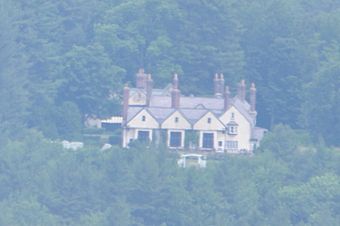Fasnacloich facts for kids
Quick facts for kids |
|
|
Fasnacloich
|
|

The main house, as seen from several miles away on Mount Monadnock
|
|
| Location | Four Hill Rd. N of Dublin town line, Harrisville, New Hampshire |
|---|---|
| Area | 1.3 acres (0.53 ha) |
| Built | 1911 |
| Architect | Bell, A.S. |
| Architectural style | Late 19th And 20th Century Revivals, Late Medieval English manor |
| MPS | Harrisville MRA |
| NRHP reference No. | 86003245 |
| Added to NRHP | January 14, 1988 |
Fasnacloich is a beautiful old country estate in Harrisville, New Hampshire. It was built in 1911 and made even bigger between 1916 and 1917. This estate is one of the most impressive summer homes built in the Harrisville-Dublin area. This region was very popular for summer vacations back then.
The estate was built by Charles MacVeagh and Fanny Davenport Rogers MacVeagh. Charles MacVeagh was an important person who served as the United States Ambassador to Japan. Their son, Lincoln MacVeagh, also became a diplomat. Fasnacloich was added to the National Register of Historic Places in 1988. This means it is a special place recognized for its history.
Contents
About Fasnacloich Estate
The MacVeagh family became interested in the Harrisville-Dublin area after visiting Charles's uncle, Franklin MacVeagh, at his estate called Knollwood. The MacVeaghs had Scottish family roots. They named their new estate Fasnacloich after a place linked to Mrs. MacVeagh's family.
The Main House Design
The family wanted to build a medieval-style country estate. They chose a hillside with amazing views of Mount Monadnock. The main house was inspired by Kelmscott Manor in England. The original Fasnacloich in Scotland had burned down in the 1800s.
The house is made of stone and has two stories. It features many chimneys, which was common in Jacobean-style homes. The roof is made of slate. The window frames and wooden decorations inside the house were made from wood cut right on the property.
The house has an unusual U-shape. The main part of the U is about 114 feet (35 m) long. The two arms of the U stretch out, one about 70 feet (21 m) long and the other about 58 feet (18 m) long.
Inside the Fasnacloich Home
You reach the house by driving up a long road. It ends in a circle in front of the eastern side of the house. This side has two entrances with porches.
The main part of the house has an entry hall, three bedrooms, and a very large hall. This grand hall is about 60-foot (18 m) long. Its walls are decorated with a half-timbering style, using wood and stucco.
The south wing of the house holds a library and another big room called the "Terrace Room." This room is about 17 feet (5.2 m) by 55 feet (17 m) and has two stories. It was used for performances and shows. It has three fireplaces and three huge windows made of small, leaded glass panes. These windows are under steeply sloped gables. A covered walkway connects the south wing to the north wing.
The north wing of the house contains the kitchen and areas for servants. It also has a large dining room and a smoking room on the first floor. On the second floor, there is an Episcopal chapel. An addition built in 1916-17 is located north of this wing. It holds a much larger library. This library is about 31 by 46 feet (9.4 m × 14.0 m) and has bookshelves lining the walls. These shelves are separated by pairs of columns.
Gardens and Terraces
One of the most striking parts of the estate's outdoor area is a four-level terrace. This terrace stretches down the hill from the south wing of the house. The top level has a stone wall with a decorative railing. The garden goes down to the fourth level. Here, you'll find an eight-sided pool with a fountain in the middle. This fountain was brought all the way from Italy.
History of the Estate
A. S. Bell drew the plans for the house. However, Fanny MacVeagh is often given credit for most of its design and decoration. The MacVeaghs were known for inviting many interesting people to their estate. Their guests came from politics, society, art, and literature.



